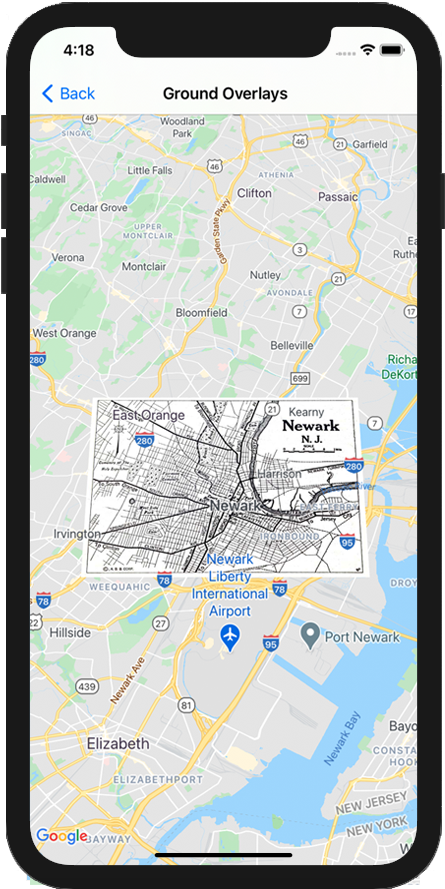Overlay bumi adalah overlay di peta yang terikat dengan koordinat lintang/bujur, sehingga akan bergerak saat Anda menarik atau melakukan zoom pada peta.

Pengantar
Overlay bumi adalah gambar yang disematkan pada peta. Tidak seperti penanda, overlay bumi berorientasi pada permukaan Bumi, bukan layar, sehingga memutar, memiringkan, atau melakukan zoom pada peta akan mengubah orientasi gambar.
Untuk menambahkan overlay tanah, buat objek
GMSGroundOverlay
yang menentukan ikon dan batas. Jika tidak menentukan salah satunya, overlay bumi tidak akan muncul di peta. Secara opsional, Anda dapat menentukan setelan tambahan yang akan memengaruhi pemosisian gambar pada peta.
Setelah menentukan opsi yang diperlukan, tetapkan properti map objek ini untuk menambahkan overlay.
Menambahkan overlay
- Membuat instance objek
GMSGroundOverlaybaru - Tetapkan properti
iconke instanceUIImage. - Tetapkan properti
boundske instanceGMSCoordinateBounds. Batas merepresentasikan sudut barat daya dan timur laut gambar. - Tetapkan properti opsional, seperti
bearingdanzoomLevel, sesuai keinginan. - Tetapkan properti
map- gambar akan muncul di peta.
Contoh di bawah menunjukkan cara menambahkan overlay bumi ke objek
GMSMapView yang ada.
Swift
let southWest = CLLocationCoordinate2D(latitude: 40.712216, longitude: -74.22655) let northEast = CLLocationCoordinate2D(latitude: 40.773941, longitude: -74.12544) let overlayBounds = GMSCoordinateBounds(coordinate: southWest, coordinate: northEast) // Image from http://www.lib.utexas.edu/maps/historical/newark_nj_1922.jpg let icon = UIImage(named: "newark_nj_1922") let overlay = GMSGroundOverlay(bounds: overlayBounds, icon: icon) overlay.bearing = 0 overlay.map = mapView
Objective-C
CLLocationCoordinate2D southWest = CLLocationCoordinate2DMake(40.712216,-74.22655); CLLocationCoordinate2D northEast = CLLocationCoordinate2DMake(40.773941,-74.12544); GMSCoordinateBounds *overlayBounds = [[GMSCoordinateBounds alloc] initWithCoordinate:southWest coordinate:northEast]; // Image from http://www.lib.utexas.edu/maps/historical/newark_nj_1922.jpg UIImage *icon = [UIImage imageNamed:@"newark_nj_1922"]; GMSGroundOverlay *overlay = [GMSGroundOverlay groundOverlayWithBounds:overlayBounds icon:icon]; overlay.bearing = 0; overlay.map = mapView;
Menghapus overlay
Anda dapat menghapus overlay bumi dari peta dengan menyetel properti map GMSGroundOverlay ke nil. Atau, Anda dapat menghapus semua overlay (termasuk overlay bumi yang saat ini ada di peta) dengan memanggil metode GMSMapView clear.
Swift
mapView.clear()
Objective-C
[mapView clear];
Jika ingin melakukan modifikasi pada overlay bumi setelah menambahkannya ke peta, pastikan Anda tetap mempertahankan objek GMSGroundOverlay. Anda dapat
memodifikasi overlay bumi nanti dengan membuat perubahan pada objek ini.
Swift
let overlay = GMSGroundOverlay(bounds: overlayBounds, icon: icon) overlay.bearing = 0 overlay.map = mapView // ... overlay.isTappable = true
Objective-C
GMSGroundOverlay *overlay = [GMSGroundOverlay groundOverlayWithBounds:overlayBounds icon:icon]; overlay.bearing = 0; overlay.map = mapView; // ... overlay.tappable = YES;
Acara
Anda dapat memproses peristiwa yang terjadi di peta, seperti saat pengguna mengetuk overlay. Untuk memproses peristiwa, Anda harus menerapkan protokol
GMSMapViewDelegate. Lihat
panduan peristiwa dan daftar metode di
GMSMapViewDelegate.

